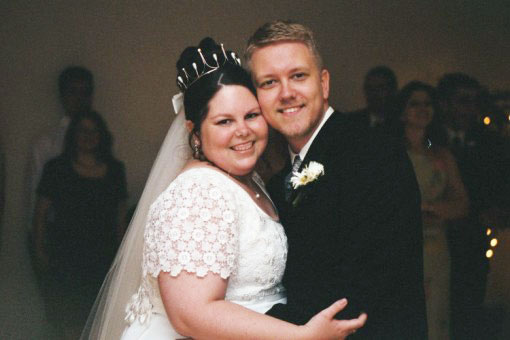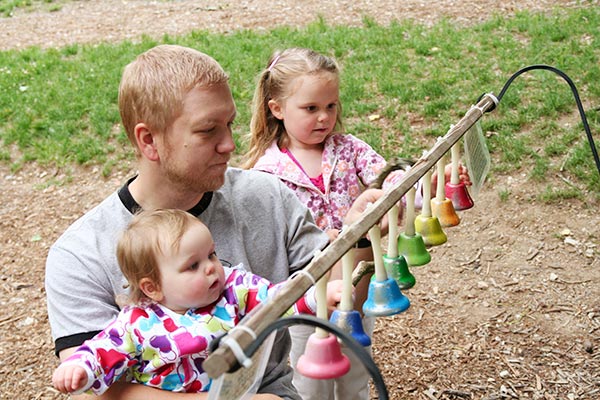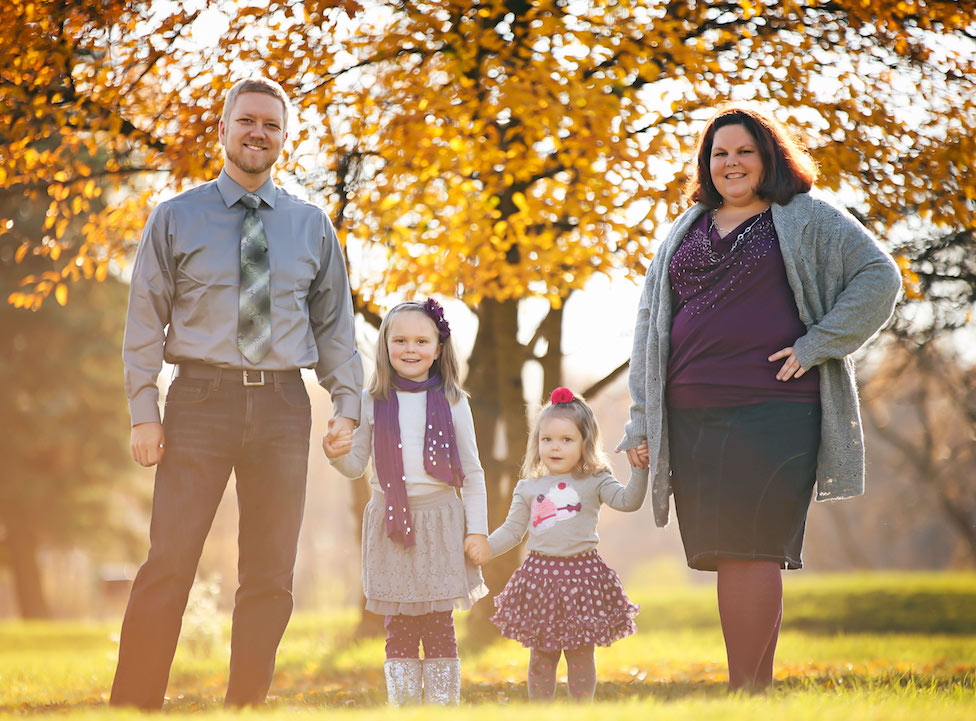When Nicole Kinnunen started dating her husband-to-be, she spotted a large, strange-looking mole on his leg. He told her it was nothing. Eleven years after they married, that melanoma left their family without a husband and father.
Nicole Kinnunen vividly remembers her first impressions of the tall blond man from Finland who would become her husband. They met in 1999 while students at Eastern Michigan University. Mikko seemed reserved but confident, and he had a mysterious accent, brilliant blue eyes and a sincere smile.
After their relationship began, Nicole noticed a large mole, about the size of a quarter, on Mikko’s thigh. “It was bigger than any mole I’d seen before,” she says. “It didn’t look right to me. I remember that we discussed the shape, size and color, but he assured me he had had it his whole life. He said it was no big deal.” She thinks of that often now, and wishes she had forced Mikko to have that mole examined. She will always wonder if things might have been different. Nicole quickly learned, however, that Finnish people typically don’t talk much about their problems or feelings, “and Mikko even less,” she says. He didn’t like going to the doctor, either, so no expert monitored his mole over the years.

Wedding Day in 2002 – Nicole was the outgoing one, and Mikko had that famous Finnish reserve, but somehow their combination worked.
The Scratch That Never Healed
Nicole was much more open and outgoing than Mikko, while he was deliberate in expressing his thoughts, but their styles complemented each other. They married in 2002, bought a house, adopted a dog and welcomed two daughters. In the summer of 2011, Mikko’s mole became an issue thanks to the family dog, Ronnie. One day, the dog inadvertently scratched the mole. In September, when the wound still hadn’t healed, Mikko finally saw a dermatologist. The doctor took one look and immediately expressed concern that it was cancer. A biopsy showed that the mole was a stage II melanoma, meaning the tumor was at risk of spreading, or metastasizing, to the lymph nodes or even beyond. Mikko still acted as if it were nothing, Nicole recalls.
He had surgery to remove the mole, and a biopsy found no evidence the cancer had reached the lymph nodes. Drug therapy followed. “Our children were so young: Fiona was 5 and Phoebe was 2. I had to concentrate on them and couldn’t fully focus on gathering as much medical information as I could,” Nicole says. “But the doctors and nurses were optimistic that everything looked very good. We thought Mikko would be fine.” She felt reassured knowing he would follow up with the doctors for checkups.
Mikko mostly kept his illness to himself. “We told only our closest inner circle of family and friends,” she recalls. “He had chosen not to tell his sister in Finland about the cancer until after the surgery. We also decided at that time to tell our girls only that he had a piece of bad skin removed.” After this health scare, Nicole and Mikko made an effort to do more together as a family. They joined Mikko’s sister and her family on a vacation at Disney World. “We had a great time. Seeing the enjoyment on Mikko’s face, I knew he was really glad we went,” Nicole says.
The Cancer Advances
One year after the diagnosis, in the fall of 2012, Mikko started feeling sluggish and noticed that the lymph nodes in his groin were swollen. When his doctors ran more tests, everyone was shocked to learn the cancer had not only returned, but advanced. Just after Thanksgiving, he was diagnosed with stage IV melanoma: The disease had metastasized to other parts of his body.
“I knew that was bad but didn’t process the full scope of what it meant,” Nicole recalls. “We both sat with his doctor and heard the diagnosis. We heard the treatment plan, and we heard that the five-year survival rate at this stage was only about 16 percent. But I don’t think either of us really grasped it.” They just focused on keeping up with their day-to-day life. In early December they told their family and friends. Everyone was stunned but believed that Mikko would be in that survival group.
Mikko still managed to commute to his IT job and Nicole to her digital archivist work. But Mikko’s health was deteriorating fast. His best friend, John Troung, is married to Nicole’s best friend, Kristen, and both were incredibly supportive. From John, Nicole learned later that Mikko had talked to him in private about symptoms she didn’t know he had, including an episode when he nearly passed out in the shower. He didn’t want to worry his family. Despite various intensive treatments over the next three months to deal with the melanoma and metastases to his lungs, Mikko had more and more fatigue and trouble eating and concentrating.
Nicole was beginning to accept the reality that her husband might not survive.
Preparing for the Worst
On St. Patrick’s Day in 2013, Mikko couldn’t eat and kept dozing off. At one point Nicole woke him to ask if he’d be able to work the next day. “When he couldn’t put the words together to answer me, I knew I had to take him to the ER,” Nicole says. The cancer had reached Mikko’s brain. After trying radiation treatments unsuccessfully, the doctors said there was no more they could do. It had been just four months since Mikko’s stage IV diagnosis. Nicole asked for hospice care at home.
She made the difficult call to Finland to tell his sister to come as soon as possible, then called other family and loved ones. Nicole had already explained cancer in simple terms to the children, based on information a social worker had provided. Now she knew it was time to tell Fiona, then 6, more to help prepare her. She took Fiona out to lunch alone and explained that her daddy was going to come home but would soon pass away. Fiona responded as any child would. “I don’t want Daddy to die,” she cried, and also expressed concern for her younger sister.
Nicole knew that at only 3 years old, Phoebe wouldn’t understand, so she decided to shield her from the full story. Many relatives and friends came from out of town to support the family, which helped distract the girls. Soon Nicole made the hard choice to have her daughters stay with a relative to spare them what was about to come. She says she’s grateful, though, that “Fiona and Phoebe first had time with their dad at home to say goodbye, whether or not that’s what they knew they were doing.” Mikko passed away on April 1, 2013 at age 35.

Vivid Memories – Even though Fiona was only 4 and Phoebe only 2 when their father was diagnosed, they remember many good times together.
Coping with Grief
In the early stages of grieving, Nicole was in shock. Each night at least one friend stayed at her house so that she didn’t have to be alone. “I would go up to my room and cry, or sleep or just be. Someone was there to catch me.” She tried to keep her head above water, managing the household as a single parent. “I didn’t feel anything. I just wanted to keep moving. Waking up and going to sleep, taking my children to day care and school, going to work, managing the house. But no matter what I did, I felt like I was always three days behind.”
Social media came to Nicole’s rescue. John had started a Facebook group of friends and family to boost Mikko’s spirits during his melanoma treatments. Now that group focused on helping Nicole. They had a system that Nicole calls “sounding the Viking horn.” Anytime she gave a hint of having a particularly bad day, they would network with each other, and people would check in with her by Facebook, text or email, or would call or come over.
Nearly 10,000 people die of melanoma each year in the U.S. But the impact of the disease is far wider, as it can devastate family and friends.
Nicole wasn’t the only one deeply affected by Mikko’s death. Besides his family in Finland, his best friend John was also bereft. For years the two men had been as close as best friends could be, playing video games, creating themed Halloween costumes, joining a golf league and going out most Saturday nights. “I considered John’s grieving on par with my own,” said Nicole. “At times I couldn’t speak with John without getting choked up because I recognized that both of us were going through this process.”
One way John channeled his grief was by organizing a charity golf outing in his friend’s honor. The Mikko Kinnunen Memorial Golf Scramble has become an annual event at their favorite course in Ann Arbor, Michigan, and has raised thousands of dollars for The Skin Cancer Foundation.
Nicole has also worked to keep Mikko’s memory alive with her daughters, even if talking about him sometimes brings her to tears. “Fiona talks about her memories of going sledding with him and carving pumpkins, of going for swimming lessons with him and getting donuts to bring home. I’m amazed by how detailed her memories are.”
Phoebe handles her grief in a more abstract way. Sometimes she asks when her father is coming home. But Nicole suspects that’s just her way of saying, “I miss him and want him back.” Phoebe remembers riding Prince Charming’s carousel at Disney World with her father by her side. “She likes to ride it when we are there and always mentions her father while the ride goes round and round,” Nicole says.
While Nicole is not particularly religious, she talks to the girls about heaven, as a place where their father is in peace. The girls imagine that in heaven their dad has a gold iPhone. “Apparently everything is gold in heaven,” jokes Nicole. And when he’s not watching over them, his daughters say, he’s playing on his iPhone and rooting for the Detroit Red Wings, his favorite hockey team. On his birthday or Father’s Day she helps the girls write messages to Mikko, which they put into balloons they can release up into the sky for him.
Push for Early Detection
Almost three years since her husband’s death, Nicole is just starting to feel like herself again. But in her darkest moments, she’s still haunted by the question: If he had had his mole checked and removed back in 2002, when she first saw it, would Mikko still be alive? She now knows that the five-year survival rate in the U.S. for a person whose melanoma is detected early, before it has spread, is about 99 percent. “If I could just go back in time, I would say, ‘You’re going to get this mole checked out right now,’ and drag him to the doctor, compliant or kicking and screaming.”
She quickly puts these thoughts aside, realizing she can’t change the past. But anytime she sees someone with an abnormal-looking mole, she respectfully urges the person to make the lifesaving choice and have it checked. “Knowing what was at stake could have made the difference for Mikko and our family.”
*This article was first published in the 2016 issue of The Skin Cancer Foundation Journal.





